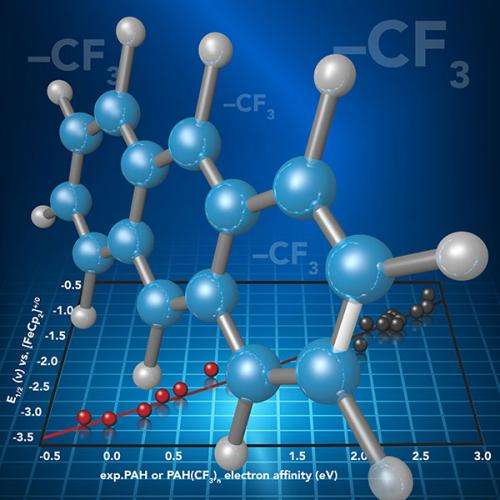One-pot synthesis transforms ubiquitous hydrocarbons into electron attractors

Without using a solvent, catalyst, or promoter, scientists at Pacific Northwest National Laboratory (PNNL) and Colorado State University transformed a common molecule that abhors electrons into one with a strong affinity for them. The team's synthesis route begins with polycyclic aromatic hydrocarbons, or PAHs. These molecules contain common carbon and hydrogen, and scientists want to quickly tailor or functionalize them to replace materials that use rare metals. The new synthesis route adds perfluoroalkyl groups (-CF3) via thermally hot radicals to a PAH; the resulting molecule has a strong affinity for electrons.
"PAHs don't like electrons at all," said Dr. Xue-Bin Wang, a PNNL chemical physicist who led the gas phase characterization of the study. "We've made them like them."
Replacing metal-based materials with tailored ones made from abundant carbon, hydrogen, or other elements could provide sustainable, lower cost solar devices, catalysts, and other materials. Creating tailored materials requires expertise, insights, and a foundational understanding of the material's behavior at molecular level. This study demonstrates a direct, one-pot synthesis route, but not for creating high yields of the material, rather for building "textbook" molecules, which will be pored over to understand the material's electronic properties and solid-state shapes. The subsequent gas phase study elucidates a close correspondence among electron affinity, number of added CF3 groups, and PAH molecular structure.
While scientists have tried to fine-tune PAHs to build new materials for some time, functionalizing PAHs has been notoriously complex and resulted in low yields of delicate products. Scientists want a process that does not require complex steps. The team's route uses only one "pot" and is free from solvents, catalysts, or other promoters. The reaction mixes a thermally stable PAH with gaseous CF3I and high heat.
"Using a solvent-free, catalyst-free approach is very new," said Wang.
After combining PAH and CF3I, the following steps probably occur-the exact reaction steps will need to be delineated in a follow-on study:
- "Hot" CF3 radicals form as a result of the gaseous CF3I dissociating in the heat. A radical is an atom, ion, or piece of a molecule that has an unpaired electron. The unpaired electron makes the radical highly reactive.
- The radical removes a hydrogen atom on the outer edge of the PAH, creating a CHF3 radical and a PAH radical.
- The PAH radical reacts with another CF3 radical, resulting in the functionalized PAH.
These three steps can continue for some time, resulting in a PAH with one or more new functional groups and a high affinity for electrons.
To test the synthesis route, the team created seven functionalized PAHs, PAH(CF3)n. To measure the electron affinity of each functionalized PAH and to characterize other intrinsic molecular properties, the team first converted neutral molecules into the corresponding anions, PAH(CF3)n•-, by adding one extra electron in solutions. They used electrospray ionization to generate gaseous PAH(CF3)n•- anions from such solutions. The respective electron affinity and electronic structure of each PAH(CF3)n were directly obtained by a photodetaching electron from each corresponding PAH(CF3)n•- anion in the gas phase using low-temperature photoelectron spectroscopy.
Such a gas phase study rendered an accurate and quantitative measurement of incremental increase in the electron affinity per CF3 group for isomer-selective functionalized PAHs, and the study also revealed substantially different stepwise increases of electron affinity per CF3 for different classes of PAHs, thus providing the most fundamental molecular information to shed light on designing principles for rational synthesis of targeted materials with desired electron affinities. The resulting seven materials were stable under a range of conditions and had other traits that could make them ideal candidates for fundamental studies of the connection between structure and function.
"The actual affinity can be finely tuned," said Wang. "Specifically, we can control how many CF3 groups are added and in what position."
The team is continuing to examine how changes to the structure of the molecules affect their function. They are examining other PAHs, including corannulene, with chlorine-based molecules.
More information: Kuvychko IV, KP Castro, SHM Deng, XB Wang, SH Strauss, and OV Boltalina. 2013. "Taming Hot CF3 Radicals: Incrementally Tuned Families of Polyarene Electron Acceptors for Air-Stable Molecular Optoelectronics." Angewandte Chemie International Edition 52:4871-4874. DOI: 10.1002/anie.201300085
Journal information: Angewandte Chemie International Edition
Provided by Pacific Northwest National Laboratory

















